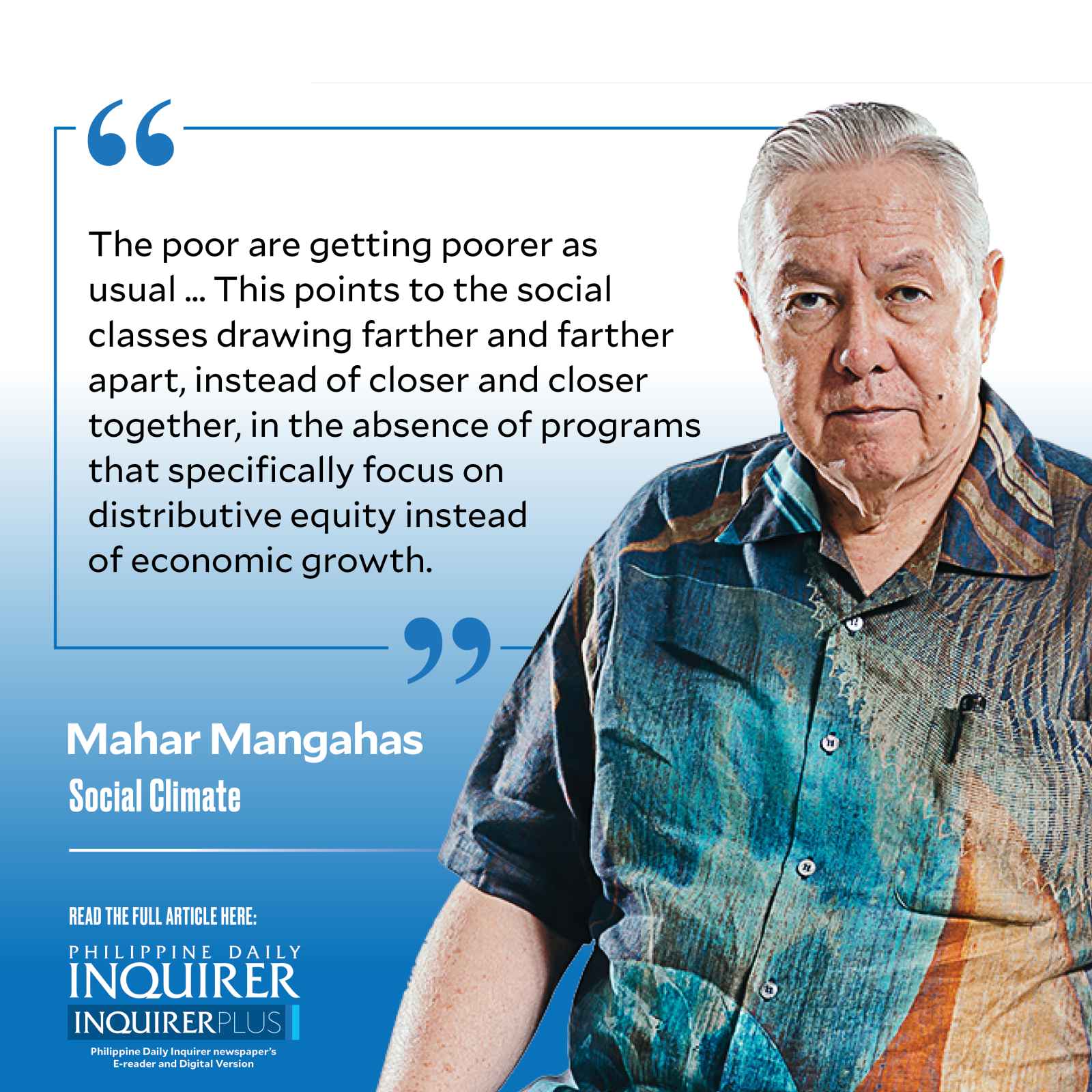Throwback to loser-dominance

The disappointing news in the Third Quarter 2023 Social Weather Survey is that Losers have regained their dominance (“Gainers minus Losers falls to -2 in September from +11 in June,” www.sws.org.ph, 11/25/23).Last June’s +11 had bested March’s +5, the +8 in December 2022, and the zero in October 2022. But September’s -2 is a throwback to June and April of 2022 and does not align with the reported acceleration in gross national product in 2023.
This indicator refers to the trend—as distinct from the status—in the Quality of Life (QOL, uri ng pamumuhay) as seen by the (adult) survey respondents in the 12 months before they were interviewed. A trend can be up, or down, or stationary.
The indicator simply compares the proportions that went up (the Gainers) and went down (the Losers) during the period. It does not know the distance traveled by either. What the survey finds is how many got more pie, and how many got less pie, compared to a year ago; it does not see how much pie people are getting now or how much they got before.
The Gainers were 28 percent in September, down significantly by 5 from 33 in June. The Losers were 30 percent, up significantly by 8 from 22. Those with a steady QOL, whom I like calling “Floaters,” were 42 percent in September (41, correctly rounded), down by 3 from 45. The error margin is plus/minus 3 points.
The Net Gainers score of -2 for September is a big drop from the +11 in June. It can be said that Gainers and Losers are virtually tied as of now, but, still, it is sad that the Gainers have lost the lead that they had for three consecutive quarters. (This sounds like a basketball game review.)
The September 2023 Social Weather Stations (SWS) survey was a great milestone: the 150th nationwide measurement of Gainers and Losers since 1983. In those 150 surveys, Losers led 126 times, and Gainers led only 24 times.
In the long stretch of 1983-2014, Net Gainers led only two times, despite the persistent growth in gross national product per capita. This is the basic historical evidence that aggregate economic growth has little, if any, trickle-down effect.
But there was a dramatic turnaround in 2015-2019, when Gainers took command. At first, from 2015Q1 up to 2016Q2, the Gainers had single-digit leads. Then, in 2016Q3 up to 2018Q1, they had double-digit leads, with a record high +23 in December 2017.
Net Gainers dropped to +5 in 2018Q2, and to -2 in 2018Q3. But it quickly recovered to double digits in 2018Q4 up to 2019Q4, and was at +18 just before the COVID-19 pandemic.
What explains the historic shift to a Gainer-dominant economy in 2015-19? What role was played by the moderation in inflation in the cost of living?
Then catastrophe struck in 2020. Net Gainers sank to the all-time record depth of -78 in May; at the end of 2020 it was at -48. In 2021, the deficit started at -38 and gradually narrowed to -16, which we term “mediocre.”
In 2022, Net Gainers started at -2 and was 0 in October, both of which we call “fair.” It was positive again from December 2022 to June 2023, until the disappointment of last September.
Geographical patterns should be noted. An SWS national survey is built up from surveys in the National Capital Region (NCR), Balance Luzon, Visayas, and Mindanao; at the area level, the error margin is plus/minus 6 points. In March and June this year, Gainers dominated everywhere; but in September they dominated only in Balance Luzon.
The latest Net Gainers score was down by a huge 27 points in the NCR, from +18 to -9; NCR has the worst trend of all areas. In Visayas, it was down by 17, from +10 to -7. In Mindanao, it fell by 6, from +2 to -4. Only in Balance Luzon, where it fell by 10, from +13 to +3, did it stay positive.
Are there differences in the rates of inflation across these areas? Are there any “El Niño” or “La Niña” factors in play? Can regional development specialists provide explanations?
The poor are getting poorer as usual. Broken down by their families’ poverty status, the latest Net Gainers score is an unfavorable -9 among the Self-Rated Poor, compared to favorable scores of +4 among the Borderline, and +5 among the Not Poor.
Classified by their families’ hunger status, the latest Net Gainers scores are -21 among the Severely Hungry, -12 among the Hungry, and -1 (i.e., similar to the national score) among the Not Hungry.
Classified by their own schooling level, Net Gainers now score -15 among elementary dropouts, -10 among junior high school dropouts, +3 among JHS finishers, and +9 among college graduates.
In short, those living on lower floors are disproportionately found on the down-escalators, while those on higher floors are disproportionately found on the up-escalators.
This points to the social classes drawing farther and farther apart, instead of closer and closer together, in the absence of programs that specifically focus on distributive equity instead of economic growth.
—————-
Contact: mahar.mangahas@sws.org.ph.
















